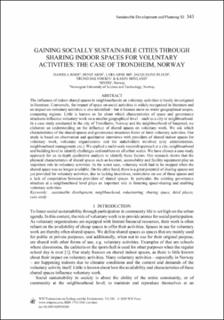| dc.description.abstract | The influence of indoor shared spaces in neighbourhoods on voluntary activities is barely investigated in literature. Conversely, the impact of space on social activities is widely recognized in literature and an impact on voluntary activities is also identified – but it focuses more on wider geographical scopes, comparing regions. Little is known so far about which characteristics of space and governance structures influence voluntary work on a smaller geographical level – such as a city or neighbourhood. In a case study conducted in the city of Trondheim, Norway and the neighbourhood of Saupstad, we elaborate an understanding on the influence of shared spaces on voluntary work. We ask which characteristics of the shared spaces and governance structures foster or limit voluntary activities. Our study is based on observation and qualitative interviews with providers of shared indoor spaces for voluntary work, voluntary organizations and the stakeholders involved (city administration, neighbourhood management, etc.). We applied a multi-scale research approach at a city, neighbourhood and building level to identify challenges and enablers on all urban scales. We have chosen a case study approach for an in-depth qualitative analysis to identify these factors. Our research shows that the physical characteristics of shared spaces such as location, accessibility and facility equipment play an important role in voluntary activities. In the worst case, voluntary work had to be stopped when the shared space was no longer available. On the other hand, there is a great potential of sharing spaces not yet provided for voluntary activities, due to lacking incentives, restrictions on use of these spaces and a lack of cooperation between providers of shared spaces. In particular, the existing governance structure at a neighbourhood level plays an important role in fostering space-sharing and enabling voluntary activities. | en_US |
